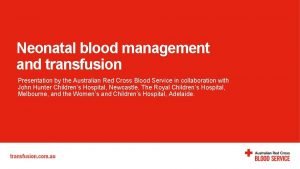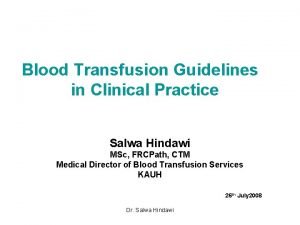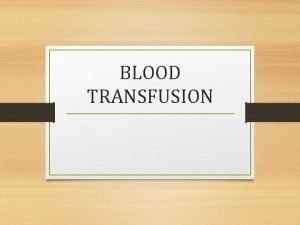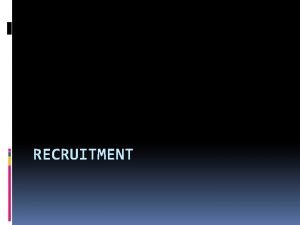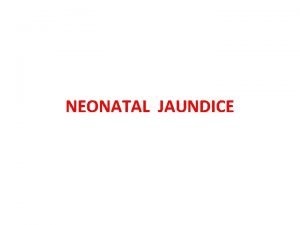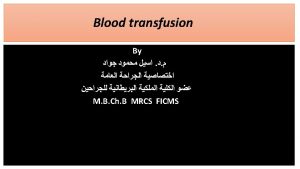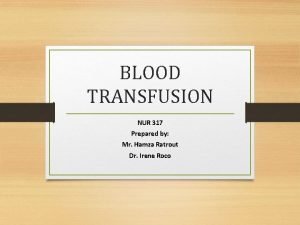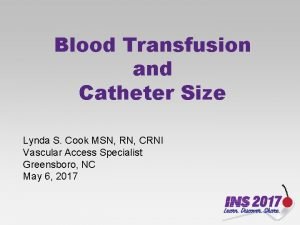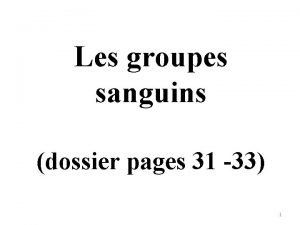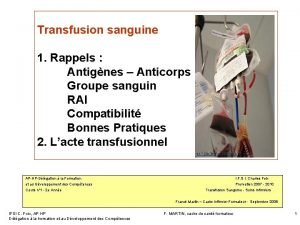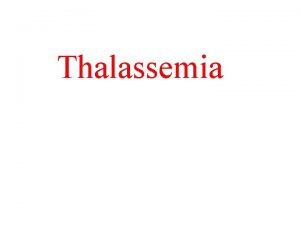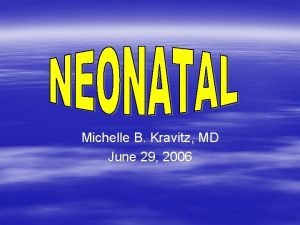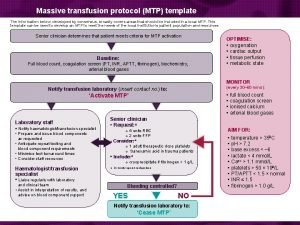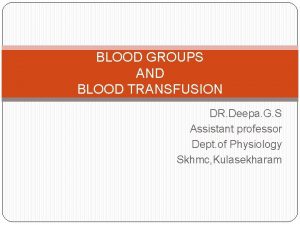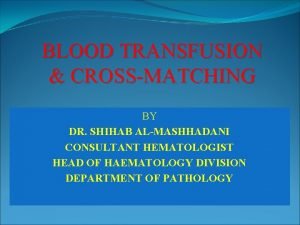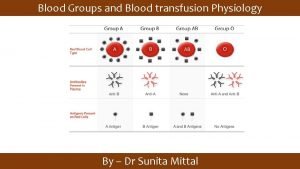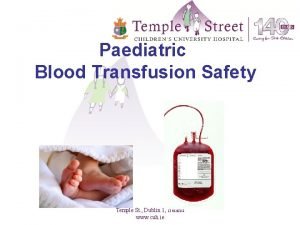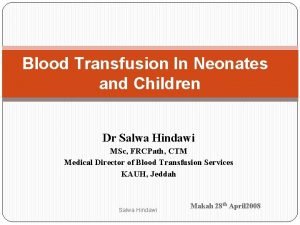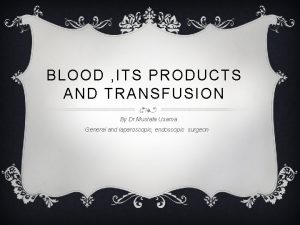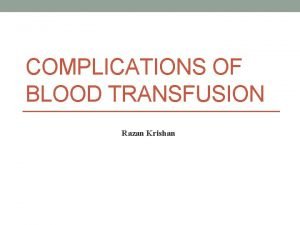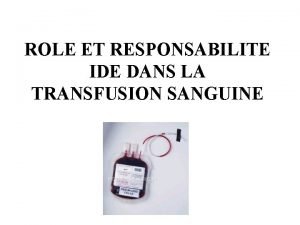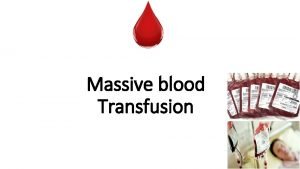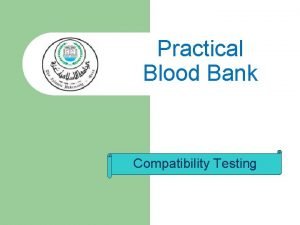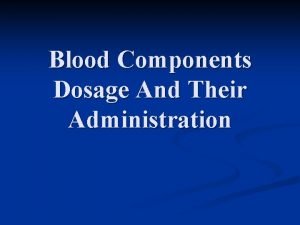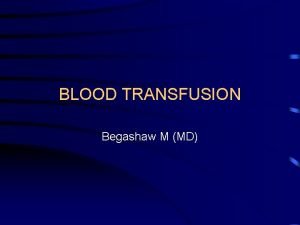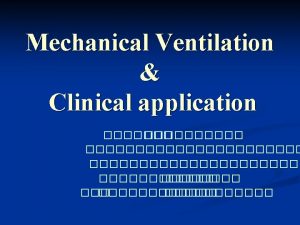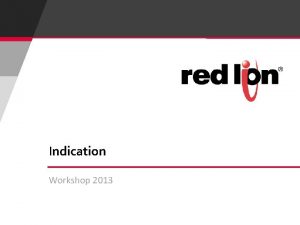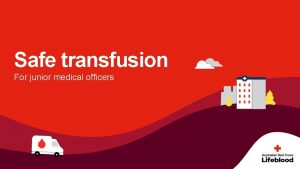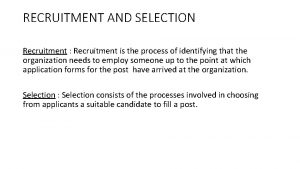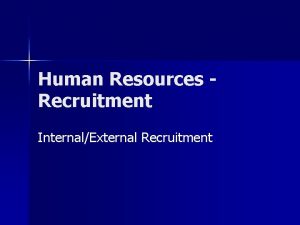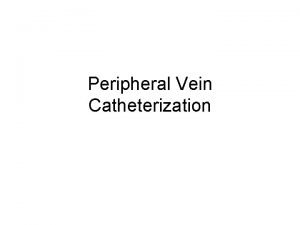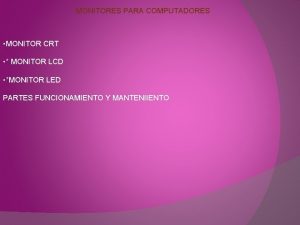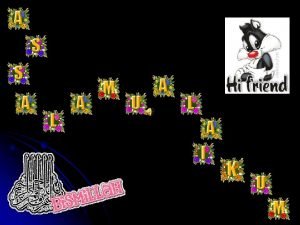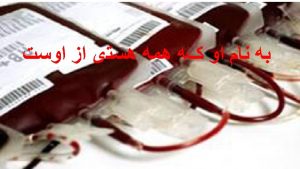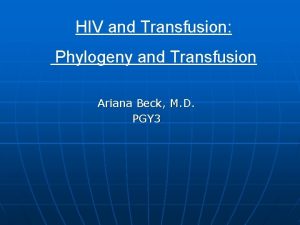Recruitment Monitor Evaluate Issue Medical Indication for Transfusion




































- Slides: 36




Recruitment Monitor & Evaluate Issue Medical Indication for Transfusion Donor Screening Administer Pre-transfusion Testing Collection & Preparation Infectious Disease Testing Product: Blood Safety Entire process: Blood Transfusion Safety Non-Infectious Risks

Indications of Blood Therapy Low O 2 carrying capacity (LOCC) LOCC & low blood volume Bleeding due to coagulopathy

BLOOD PRODUCTS Blood-cell products whole blood packed red blood cells leukocyte-poor (reduced) red cells washed red blood cells random-donor platelets concentrates single-donor platelets concentrates [human leukocyte antigens(HLA)-matched platelets] irradiated blood products (red blood cells and platelets concentrates)- after exposure 20 to 40 Gy Pediatric bag(RBC)

BLOOD PRODUCTS ♦ Blood-plasma products Fresh Frozen Plasma (FFP) Cryoprecipitate Cryopoor plasma (CPP)

Blood bags

Whole Blood • • • 450 ml +/- 10% 63 ml CPDA-1 Hct= 36 -44% Stored at 2 -6 ºC for 35 days Contains Normal Levels of WBC and PLT

Whole Blood • Transfuse same group as patient (ABO & Rh) • 1 unit: increase Hb level about 1 g/d. L (10 g/L)& Hct by 3%. • Use blood transfusion set

WHOLE BLOOD TRANSFUSION-indications Acute hypovolemia (hemorrhagic shock) Massive transfusion (>4 -5 L/24 hr ) Exchange transfusion in infants

Contraindications of Whole Blood Congestive heart failure Chronic anemia

Blood product preparation

Blood product preparation PLT PRBC FFP

Packed red blood cells • Prepared by removing 200 -250 ml of plasma from a unit of W. B. • 200 -300 ml • Hct= 65 -80% • Stored at 2 -6 ºC for 35 days • Do not contain functional platelets or granulocytes • Have the same O 2 carrying capacity as W. B

Packed red blood cells • • Injection up to 4 h’s Adult rate: 150 -300 ml/h Child. rate : 2 -5 ml/kg/h 1 unit: increase Hb level about 1 g/d. L (10 g/L)& Hct by 3%. • In child. 8 -10 ml/kg increase Hb level about 2 g/d. L (10 g/L)& Hct by 6%. • Consider age, symptoms, Hb level, underl. Dis. , acute/chronic, other alternatives

Packed red blood cellsindications Anemia in patient with normal blood volume Acute blood loss >15% blood volume Pre/ Post operative (Hb<9 & blood loss>500 ml) Hb<7 Thalassemia, sickle cell anemia Neonate Exchange transfusion

Other RBC products • • Washed red blood cells leukocyte-poor (reduced)red cells Irradiated red blood cells Frozen RBCs


Washed red blood cells- indications • Severe allergic reactions – 3 times • Ig. A deficient patients – 5 times • Attention: • • Decrease pr to 98% Decrease WBC to 85% Decrease RBC to 14% Stored at 2 -6 ºC for 24 h

leukocyte-poor (reduced)red cells • Contains : at least 85 %of original red cells • WBC < 5 x 106 • to prevent or avoid nonhemolytic febrile reactions (FNHTR) due to antibodies to white cells and platelets in the recipients exposed to previous transfusions or pregnancies • Reduce rate of HLA alloimmunization among hematology-oncology patients • to minimize transmission of viral disease such as CMV


Irradiated red blood cells • Gamma irradiation 2500 rad • Increase potassium level expired date 28 days • Changes WBC DNA

Irradiated red blood cells-indications • • severely immunosuppressed, immunocompromised, receive blood donated by relatives, or fetuses receiving intrauterine transfusions

Peadiatric blood bags • Quadruple blood bags • Blood collection in first bag then centrifuged and plasma separated in 2 nd bag • Packed cell divided between 3 bags • Common label for all



Peadiatric blood bags • • Volume ≈ 70 -100 ml Do not separate till request Stored at 2 -6 ºC for 35 days Aim: • Decrease donor exposure • Blood safety & blood wastage

Peadiatric blood bags-indications • NICU patients • Immature infants • <10 kg infants with repeated transfusion (eg. Septicemia, DIC, G 6 PD)

BLOOD LOSS- signs, symptoms and indication for transfusion Volume Lost m. L Clinical signs Preparation of choice % of Total Blood Vol. 500 10 20 None; tachycardia 1500 30 drop in BP 2000 40 shock No transfusion or crystalloid solution or colloids or RBC if necesssary crystalloid solution plus colloids plus RBC or blood if available



RBC transfusion in autoimmune hemolytic anemia 1. Transfusion only when Hb level is life-threatening (< 5 g/d. L) 2. Red cell products of choice: leukocyte-poor (reduced) red cells or washed red blood cells



 Fresh frozen plasma vs platelets
Fresh frozen plasma vs platelets Platelet concentrate
Platelet concentrate When to transfuse platelets
When to transfuse platelets Indications for blood transfusion
Indications for blood transfusion Indication of transfusion
Indication of transfusion Indications for blood transfusion in anemia
Indications for blood transfusion in anemia Recruitment needs are of three types
Recruitment needs are of three types Early and late complications of blood transfusion
Early and late complications of blood transfusion Blood transfusion steps nclex
Blood transfusion steps nclex Kernectirus
Kernectirus Transfusion reaction
Transfusion reaction Cryoprecipetate
Cryoprecipetate Rational blood use
Rational blood use Nursing responsibility in blood transfusion
Nursing responsibility in blood transfusion Rbc
Rbc Groupe abo
Groupe abo Antignes
Antignes Super transfusion
Super transfusion Double volume exchange transfusion
Double volume exchange transfusion Massive transfusion protocol template
Massive transfusion protocol template Blood group percentage in india
Blood group percentage in india What are the complications of blood transfusion
What are the complications of blood transfusion Haivn
Haivn Landsteiner law
Landsteiner law Cryoprecipitate dose
Cryoprecipitate dose Blood transfusion requirements
Blood transfusion requirements Blood transfusion in children
Blood transfusion in children Massive transfusion complication
Massive transfusion complication Complications of blood transfusion
Complications of blood transfusion Transfusion sanguine ide
Transfusion sanguine ide Trali symptoms
Trali symptoms Transfusion trigger
Transfusion trigger Massive transfusion complication
Massive transfusion complication Blood cross matching
Blood cross matching Hemolytic transfusion reaction
Hemolytic transfusion reaction Fresh frozen plasma contents
Fresh frozen plasma contents Complications of blood transfusion
Complications of blood transfusion
